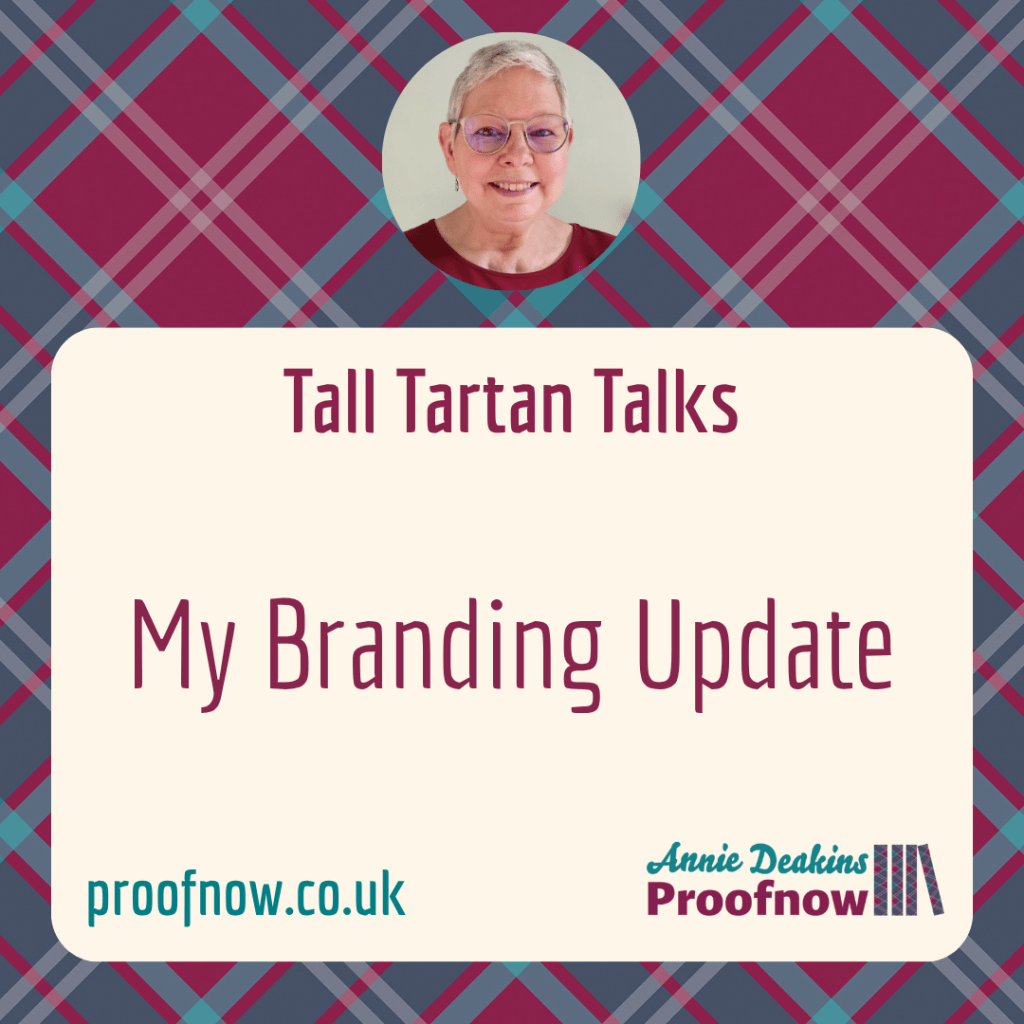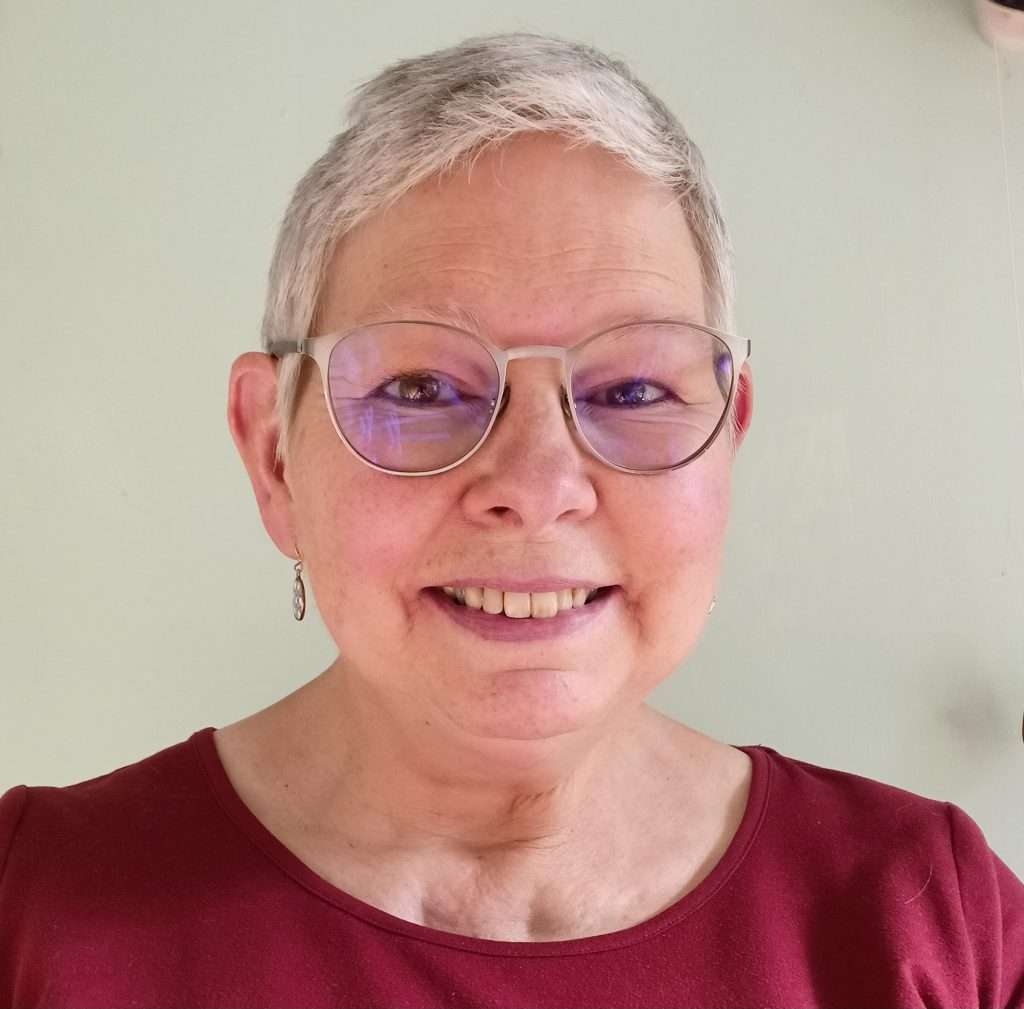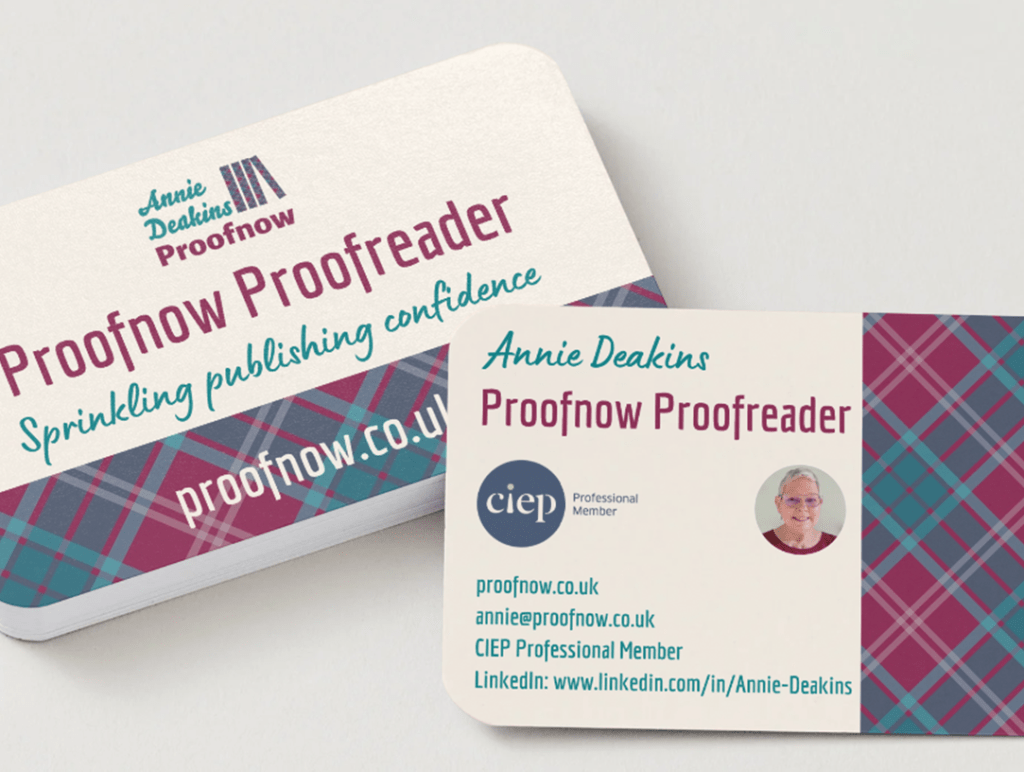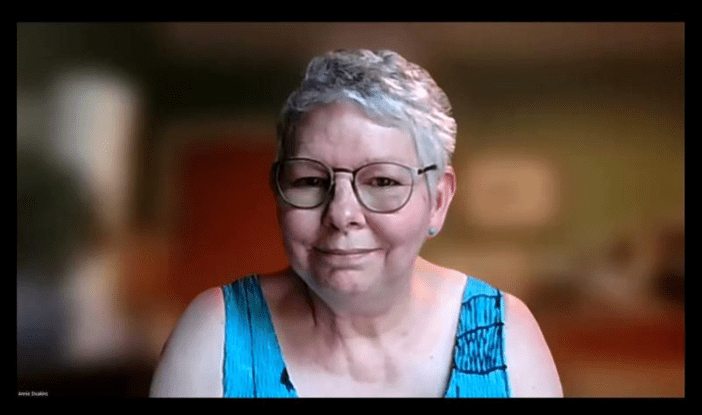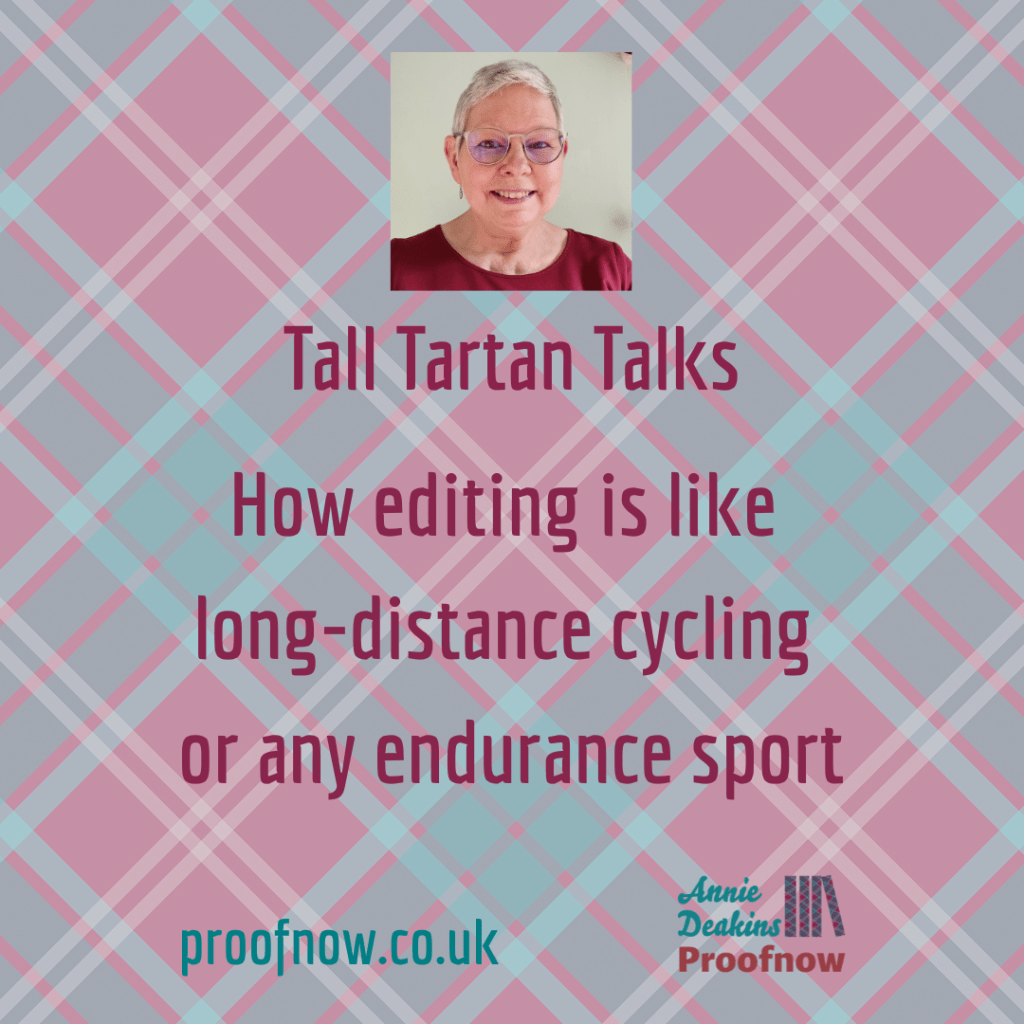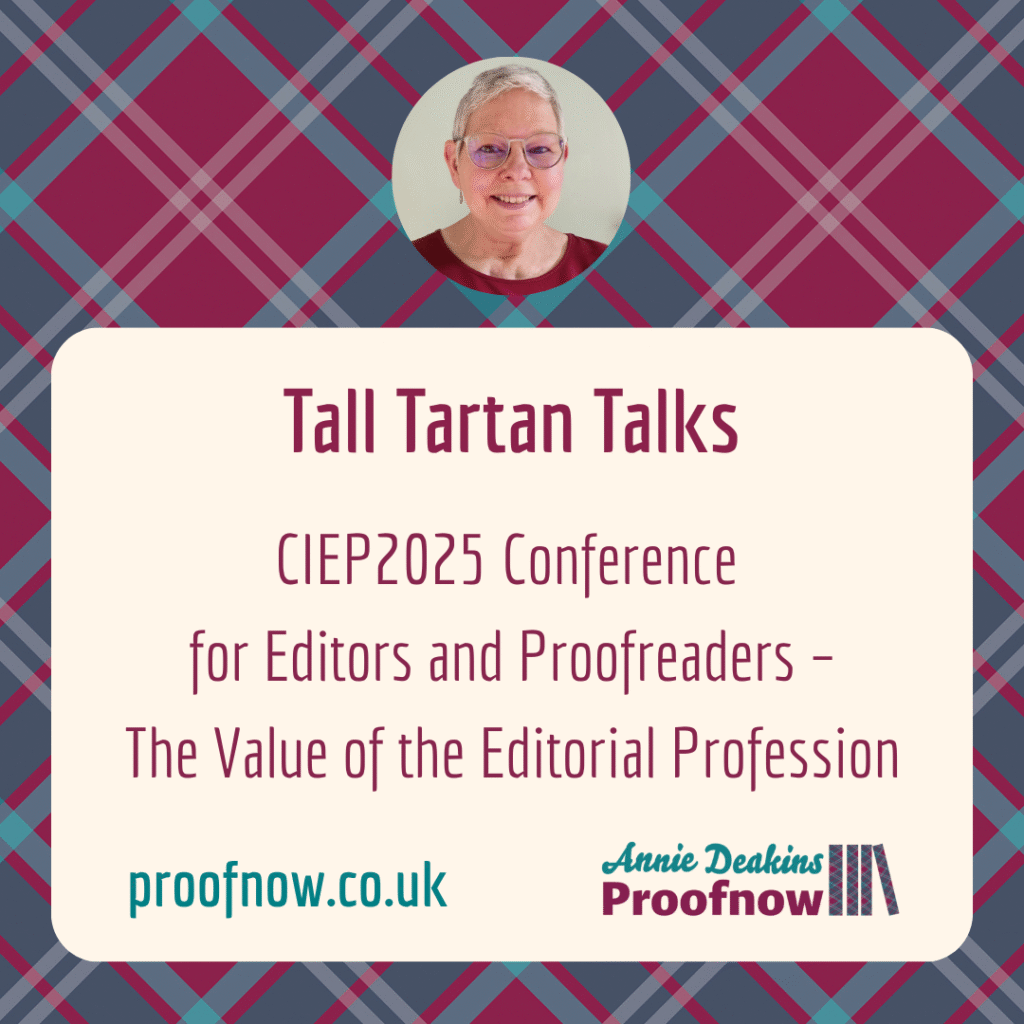
I attended the annual conference of the Chartered Institute of Editing and Proofreading (CIEP) in Milton Keynes in September.
Tall Tartan Talks here … I have gone to every conference since I started my freelance proofreading business in 2017, so 2025 was my 9th conference!
Why I attend the CIEP conference
I really enjoy being back among fellow editors and proofreaders in person. I was an online delegate in 2024. Both versions of the conference offer great opportunities for networking and Continuous Professional Development (CPD).
As the sessions are recorded and run concurrently, there is the added benefit of watching missed sessions later.
Participating in whole conference sessions
All delegates gathered together for three main events:
- A virtual Q&A with Susie Dent, the Honorary vice-president of the CIEP, interviewed by Denise Cowle, vice-chair. Susie described what it was like to have her first fiction book edited. She was relieved that her editor was going to be a human she could trust and was not going to be an AI tool.
- Viewing the film called ‘Rebel With a Clause’: Ellen Jovin was filmed by her husband Brandt Johnson taking her Grammar Table around all 50 states of the USA. People passing asked her questions about grammar and punctuation. Her responses were sympathetic. Her book of the same name recounts those conversations. The film trailer can be found at: https://www.rebelwithaclause.com/
- Closing discussion panel moderated by Jennie Seitz with three editors sharing their conference takeaways. It gave us all a warm fuzzy feeling as they revelled in what they had seen and heard.
Choosing sessions
I chose the following sessions to attend because I proofread non-fiction and will be training in copyediting by the end of the year:
- Editing as a Vocation or Ikigai: Reclaiming Our Humanity in the Age of AI, presented by Dr Sara Kitaoji
- Style sheet with editorial report, presented by Lisa de Caux
- Why bother proofreading magazines?, presented by Louise Ellins
- I, Human. Using your website to showcase the value of a human editor, presented by Debbie Emmitt
- Articulating your value in the elevator, presented by Claire Beveridge
- Beyond grammar and spelling: Ten nonfiction copyediting interventions that improve clarity and readability, presented by Marieke Krijnen.
Learning from sessions
Editing as a Vocation or Ikigai: Reclaiming Our Humanity in the Age of AI
Dr Sara Kitaoji showed us enthusiastically how to find the ‘why’ of what we do as editors. How we stay true to our authentic selves and present the human side of our business.
She asked questions such as: What brings you joy? What motivates you? She reminded us to practise self-care, to connect with other humans, and to become a trusted advisor.
Style sheet with editorial report
Lisa de Caux showed us why it is important to create a style sheet for a client and why it is quicker to work from a template to customise it for specific clients. She explained about the Editorial Report she includes as part of the SSER and took us through tailoring her template.
Why bother proofreading magazines?
I edit and proofread my local parish magazine voluntarily. I have done it since 2017, so I know this topic well. I attended this session to support another magazine proofreader. Louisa Ellins told us why she loves magazines and gave us an idea of her remit. The key with how to deal with deadlines? Diary organisation.
I, Human. Using your website to showcase the value of a human editor
Debbie Emmitt has vast expertise in this area; I always learn something new from her. Key takeaways from her session included: show yourself (include current photos and contact form / contact email address); be unique with your own selling point – bring your background to your editing niche; show your social proof in terms of testimonials. To summarise, use your website to show that you are a human editor who can be trusted.
For my part, I spend an hour weekly checking the backend of my website, checking for updates, and tweaking (adding/editing). If you look after your shop window, it will look after you.
Articulating your value in the elevator
Claire Beveridge asked us to list the objections that authors give against using an editor. Then we considered how to turn them around to give solutions to the clients’ problems; to state the value of our skills as editors, emphasising the advantages we bring.
Beyond grammar and spelling: Ten nonfiction copyediting interventions that improve clarity and readability
Marieke Krijnen showed us many ways to untangle unclear, complicated sentences to make them more concise and easier to follow. Her strategies included keeping related elements together, rearranging clauses, and removing sprawl. Her session was very enthusiastic!
I went to this session as it was a very useful resource to add to my skills of copyeditor training.
Catching up on sessions
Here are the sessions which ran concurrently. It will be useful to watch the recordings, even if they are not my subject areas. Unexpected learnings always happen which can be applied to any line of work.
- Setting new standards for PDF markup – but what should they be?, by Sarah Sodhi. I have been well-trained in the use of PDFs – as a proofreader it is my default software program. But I have heard such good things about this session, it will be the first on my watch list.
- Cleaning up a messy Word document, by Margaret Hunter
- The importance of terminology in NATO, by Vicky Drew
- I wish I could have seen that text earlier! Structured social writing, by Kate Sotejeff-Wilson
- Human in the loop: the evolving role of editors in the age of AI, by Magda Wojcik
- An introduction to marketing your editing business to indie fiction authors, by Manda Waller
- Developmental Fiction Editing Roundtable: Strategies in a Changing Landscape, by Sarah Calfee, Andrew Hodges, Sophie Playle and Aimee Walker
- 6 Lyrical tools for fiction line editors, by Louise Harnby
- An extra trick up your sleeve: adding book indexing to your editorial skills portfolio, by Paula Clarke Bain
- Authenticity in publishing: a crucial service to improve content, by Davina Bhanabhai.
Goodness, such a wealth of knowledge!
Reasons for conferencing
I was keen to meet old friends, make new ones, and to learn with laughter. Freelancing and working from home can be a lonely business. I am grateful that I belong to a collaborative and supportive network of fellow editors and proofreaders.
The CIEP conference is the best way to do CPD – I recommend it!
Many thanks to the conference team for a successful event.
I am looking forward to conferencing again in 2026!
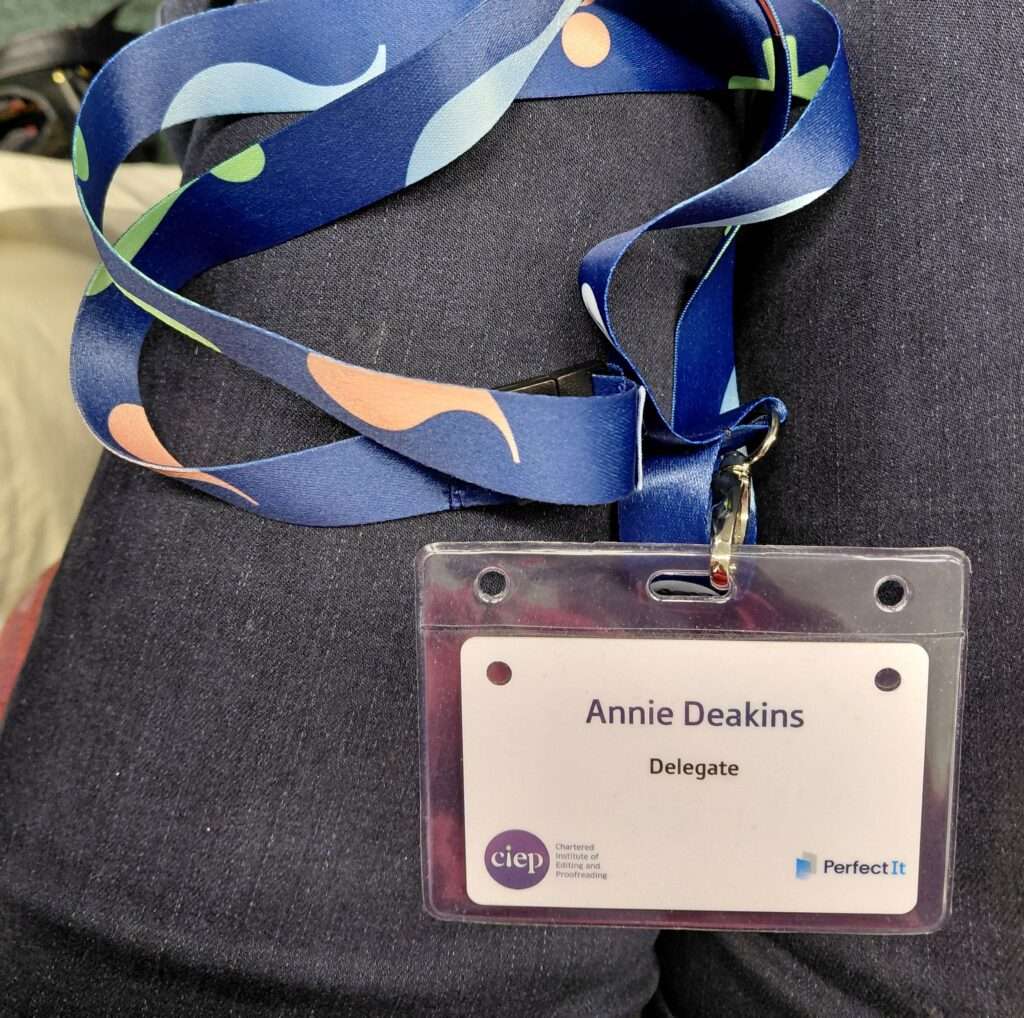
Sprinkling publishing confidence,
Annie

Reading further
Here is the link to the last conference I wrote about … in Milton Keynes … in 2022. It contains links to my posts about previous annual conferences: CIEP2022 Conference – Editing in a Diverse World
Emailing
Email me to check my availability for proofreading non-fiction and children’s books.
Subscribing
Subscribe to my newsletter Tall Tartan Times to receive new posts directly to your email.





